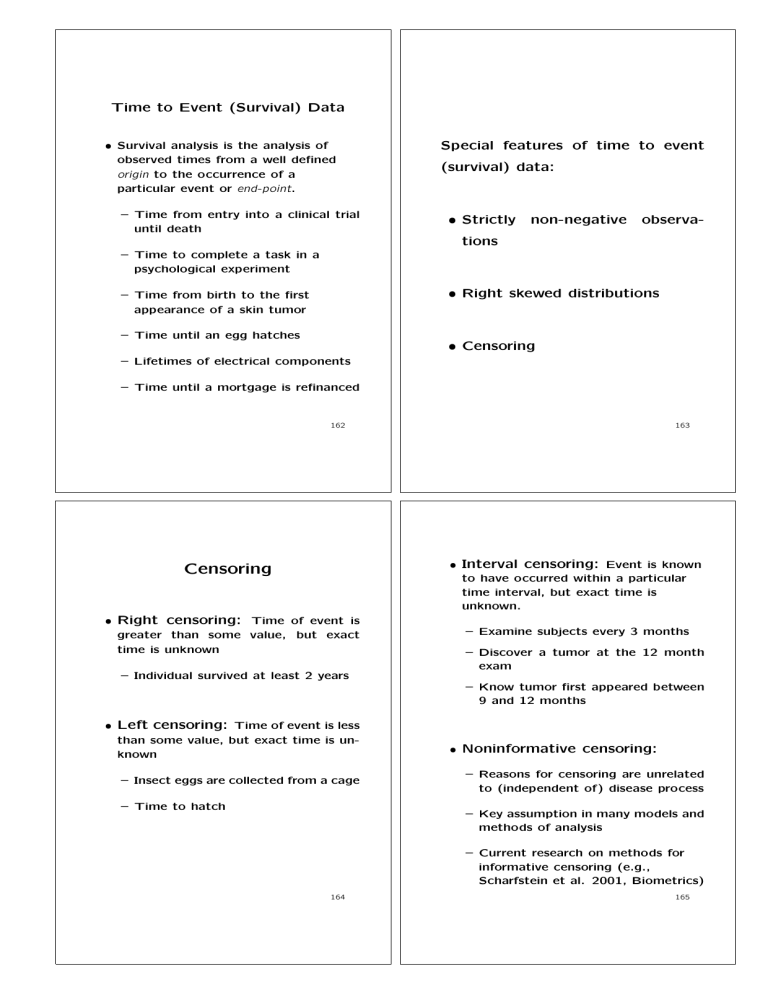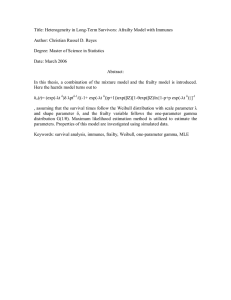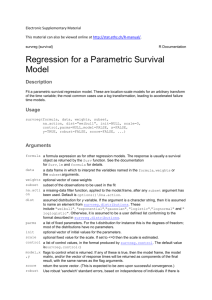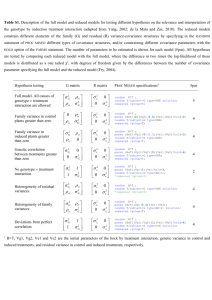Time to Event (Survival) Data Special features of time to event •
advertisement

Time to Event (Survival) Data
• Survival analysis is the analysis of
observed times from a well defined
origin to the occurrence of a
particular event or end-point.
– Time from entry into a clinical trial
until death
Special features of time to event
(survival) data:
• Strictly
non-negative
observa-
tions
– Time to complete a task in a
psychological experiment
• Right skewed distributions
– Time from birth to the first
appearance of a skin tumor
– Time until an egg hatches
• Censoring
– Lifetimes of electrical components
– Time until a mortgage is refinanced
162
163
• Interval censoring: Event is known
to have occurred within a particular
time interval, but exact time is
unknown.
Censoring
• Right censoring: Time of event is
greater than some value, but exact
time is unknown
– Examine subjects every 3 months
– Discover a tumor at the 12 month
exam
– Individual survived at least 2 years
– Know tumor first appeared between
9 and 12 months
• Left censoring: Time of event is less
than some value, but exact time is unknown
– Insect eggs are collected from a cage
– Time to hatch
• Noninformative censoring:
– Reasons for censoring are unrelated
to (independent of) disease process
– Key assumption in many models and
methods of analysis
– Current research on methods for
informative censoring (e.g.,
Scharfstein et al. 2001, Biometrics)
164
165
Example: Prostatic cancer
• Independent responses:
– The time to event for any subject
(responding unit) is stochastically
independent of the time to event of
any other subject (responding unit)
in the study
• Compare two treatments
– placebo
– 1.0 mg of diethylstibestrol (DES)
• Survival times
– Key assumption in many models and
methods of analysis
– Methods
times
for
correlated
– start-point: when patient is
randomized to a treatment
response
– end-point: death from prostatic
cancer
∗ Initially assume independence,
then make adjustments (robust
covariance estimation)
∗ Include random effects (frailty
models)
– right censoring:
∗ death from other causes
∗ lost to follow up
∗ end of study period
∗ Other models
166
• Other prognostic factors
– age of the patient
– serum hemoglobin level
– size of tumor
– Gleason index (tumor stage
and grade)
167
168
Survivor Function
The observed survival time t of an
individual is realization of a non-negative
random variable T
• Suppose T has a probability
distribution with density function f (t)
Hazard Function
The hazard function h(t) represents an
instantaneous failure rate at time t
conditional on survival up to time t.
• Consider the conditional probability of
failure between t and t + t given that
the unit survived to time t
• The cumulative distribution
function(cdf) of T, denoted by
F (t) = P (T < t) = 0t f (u)du,
represents the probability that the
observed survival time would be less
than some value t
• The survivor function of T,
S(t) = P (T ≥ t) = 1 − F (t),
represents the probability that the
observed survival time would be
greater than or equal to t.
P (t ≤ T < t+t|T ≥ t) =
S(t) − S(t + t)
S(t)
• Divide by the length of the time interval
t to get a rate
P (t ≤ T < t + t|T ≥ t)
t
• Note that f (t) = δFδt(t) = − δS(t)
δt
169
• Take the limit as t tends to zero
h(t) =
=
=
lim
P (t ≤ T < t + t|T ≥ t)
t
t→0
lim
170
Cummulative Hazard
• Note that
h(t) =
S(t) − S(t + t)
t→0
S(t) t
F (t + t) − F (t) 1
t→0
t
S(t)
lim
= f (t)/S(t)
f (t)
S(t)
• Consequently,
=−
δ
δt
{log[S(t)]}
S(t) = exp [−H(t)]
where
H(t) = 0t h(t)δt = −log [S(t)]
• h(t) t approximates the conditional
probability of failure in the interval
[t, t + t) given that the unit has
survived to time t (is at risk at time t)
171
is the cumulative hazard (or integrated
hazard)
• Survival models: often model effects of
covariates on the hazard function
172
Common Parametric Models
for
Survival Time Distributions
Weibull Distribution
• f (t) = θαtα−1exp(−θtα)
• F (t) = 1 − exp(−θtα)
• S(t) = exp(−θtα)
Exponential Distribution
• h(t) = θαtα−1:
• f (t) = θ exp(−θt)
• increasing hazard for α > 1
• decreasing hazard for α < 1
• F (t) = 1 − exp(−θt)
• Expected survival time is
E(T ) = θ −1/α Γ α−1 + 1
• S(t) = exp(−θt)
• h(t) = θ : constant hazard
• The p-th percentile is
⎡
t(p) =
⎢
⎢
⎣
1
θ
⎛
⎜
log ⎜⎝
1
1−p
1/α
⎞⎤
⎟⎥
⎟⎥
⎠⎦
173
Generalized Gamma Distirbution
Log-normal distribution
• log(T ) has a normal distribution with
mean µ and variance σ 2
• Density function
f (t) =
174
αθ ρtρα−1exp(−θtα)
Γ(ρ)
• f (t) = √1
σ 2π
• Survivor function
1 θtα ρ−1 −u
S(t) = 1 −
u
e δu
Γ(ρ) 0
t−1exp −[log(t) − µ]2/2σ 2
⎛
⎞
⎠
• S(t) = 1 − Φ ⎝ log(t)−µ
σ
• The p-th percentile
is
t(p) = exp σΦ−1(p) + µ
• Special cases
–
ρ=1
⇒ Weibull
–
α=1
⇒ Gamma
–
ρ→∞
–
α = 1 and ρ = 1
• h(t) does not have a closed form
expression
⇒ Lognormal
⇒ Exponential
175
• hazard is unimodal; zero at t=0,
increases initially, then decreases
to zero as t → ∞
176
Log-logistic distribution
• log(T ) has a logistic distribution
Example:
α−1
αt
exp(θ)
• f (t) = (1+t
αexp(θ))2
• Survival times (in months) for female
breast cancer patients:
• S(t) = (1 + tαexp(θ))−1
• The p-th percentile is
5 8 10 13 18 24 26 26 31 35 40 41
48 50 59 61 68 71 76∗ 105∗ 107∗
109∗ 113 116∗ 118 143 154∗ 162∗
188∗ 212∗ 217∗ 225∗
1/α
⎠
t(p) = ⎝ p exp(−theta)
1−p
⎛
Breast Cancer (Leathem
and Brooks, 1987, The Lancet)
⎞
α−1
exp(θ)
• h(t) = αt
1+tαexp(θ)
– Positive reaction to HPA staining
• hazard is unimodal for α > 1;
zero at t = 0, increases initially, then
decreases to zero as t → ∞
– Indicates that cancer has
metastasised to local lymph nodes
– Right censoring indicated by (*)
• hazard decreases montonically if α ≤ 1
177
178
Maximum Likelihood Estimation
Maiximize the log-likelihood
Observe (yi, di) i = 1, 2, ..., n where
Y = min(T , C)
T is the survival time
C is the censoring time
D = I{C > T } is the failure
time indicator
(α, θ) =
n
i=1
{di log(f (yi; α, θ))
+(1 − di)log(S(yi; α, θ))}
Likelihood (estimating) equations:
0 =
Contribution to the Weibull likelihood
• f (yi; α, θ) = θαyiα−1exp(−θyiα) if di = 1
• S(yi; α, θ) = exp(−θyiα) if di = 0
n
i=1
δα
δ(α, θ)
δθ
Covariance matrix for the large sample
normal distribution of the mle
⎡
−1
⎤
δ 2(α,θ) δ 2(α,θ) ⎥⎥
δ α2
δ αδ θ ⎥⎥⎥
Σ̂ = −
⎥
⎥
2
2
δ (α,θ) δ (α,θ) ⎥⎦
δ αδ θ
δ θ2
at (α̂,θ̂)
⎢
⎢
⎢
⎢
⎢
⎢
⎢
⎢
⎣
The joint likelihood
L(α, θ) =
0 =
δ(α, θ)
{f (yi; α, θ)di S(yi; α, θ)1−di }
179
180
/*
SAS code for using lifereg to
estimate parameters in a Weibull
model for survial times of breast
cancer patients. This code is
posted as weibull1.sas
*/
proc lifereg covout outest=set2;
model y*d(0)= / dist=weibull
covb
itprint
maxiter=30
converge=.0001;
output out=set3 censored=c
cdf=cdf
predicted=p
quantiles = .1 to .9 by .1
std=std;
run;
data set1;
input d y;
datalines;
1
5
1
8
1 10
1 13
.
.
.
.
.
.
0 188
0 212
0 217
0 225
run;
proc print data=set2; run;
proc print data=set3; run;
181
182
Last Evaluation of the Negative of the Gradient
The LIFEREG Procedure
Intercept
Iteration History for Parameter Estimates
Iter
Ridge
Loglikelihood
0
1
2
3
4
5
6
7
0
0
0
0
0
0
0
0
-57.439543
-53.339308
-49.33453
-48.286641
-48.15151
-48.147716
-48.147712
-48.147712
Intercept
4.033237339
5.001610136
4.896150049
4.865512502
4.865418619
4.867589108
4.867723441
4.867723441
-1.57928E-6
Scale
1.01274866
0.68236274
0.86739760
1.02688156
1.11137314
1.12881628
1.12942698
1.12942698
Scale
-0.000016155
Last Evaluation of the Negative of the Hessian
Intercept
Intercept
Scale
Scale
16.462773892
-2.81573892
-2.81573892
23.223744185
Analysis of Parameter Estimates
Model Information
Data Set
Dependent Variable
Censoring Variable
Censoring Value(s)
Number of Observations
Noncensored Values
Right Censored Values
Left Censored Values
Interval Censored Values
Name of Distribution
Log Likelihood
Parameter
WORK.SET1
Log(y)
d
0
32
21
11
0
0
Weibull
-48.14771192
Intercept
Scale
DF Estimate
1
1
Standard
Error
4.8677
1.1294
0.2491
0.2097
95% Conf
Limits
4.380 5.356
0.785 1.625
ChiSquare
381.99
Estimated Covariance Matrix
Intercept
Scale
183
Intercept
0.062029
0.007521
Scale
0.007521
0.043971
184
Pr >
ChiSq
<.0001
Contents of the file created by the outest= option
Obs
_MODEL_
1
2
3
_NAME_
_TYPE_
_DIST_
_STATUS_
y
Intercept
Scale
PARMS
COV
COV
Weibull
Weibull
Weibull
0 Converged
0 Converged
0 Converged
_LNLIKE_
y
Intercept
_SCALE_
-48.1477
-48.1477
-48.1477
-1.00000
4.86772
1.12943
4.86772
0.06203
0.00752
1.12943
0.00752
0.04397
For our parametrization of the Weibull
distribution
1
1
=
= .8854
scale
1.1294
α̂ =
⎛
Contents of the file created by the OUTPUT statement
⎜
Obs
d
y
_PROB_
p
std
cdf
c
1
2
3
4
5
6
7
8
9
.
.
.
1
1
1
1
1
1
1
1
1
5
5
5
5
5
5
5
5
5
0.1
0.2
0.3
0.4
0.5
0.6
0.7
0.8
0.9
10.238
23.895
40.584
60.889
85.951
117.800
160.353
222.561
333.520
5.128
8.889
12.393
16.312
21.474
29.106
41.300
62.613
108.156
0.05433
0.05433
0.05433
0.05433
0.05433
0.05433
0.05433
0.05433
0.05433
0
0
0
0
0
0
0
0
0
θ̂ = exp ⎜⎝
⎞
⎛
⎠
= exp ⎜⎝
−intercept ⎟⎟
scale
⎜
⎞
−4.8677 ⎟⎟
1.1294
⎠
185
= .013434
186
Compute
Use the delta method to estimate the large
sample covariance matrix for α̂ and θ̂
⎡
G =
⎛
⎜
θ̂ = exp ⎜⎝
⎞
⎛
⎠
= exp ⎜⎝
−intercept ⎟⎟
scale
α̂ =
1
scale
=
⎜
1
1.1294
⎢
⎢
⎢
⎢
⎢
⎢
⎢
⎣
δθ
δθ
δ int δ scale
δα
δα
δ int δ scale
⎞
−4.8677 ⎟⎟
1.1294
⎠
= .013434
=
−1
scale2
⎡
⎤
⎥
⎥
⎥
⎥
⎥
⎥
⎥
⎦
−int
(scale)exp scale
⎢
⎢
⎢
⎢
⎢
⎣
−int
−(int)exp scale
0
1
and
estimate the covariance matrix for
θ̂, α̂ as
= .8854
Let
⎡
V
⎡
⎢
⎢
⎢
⎢
⎢
⎣
θ
α
⎤
⎥
⎥
⎥
⎥
⎥
⎦
⎡
=
⎢
⎢
⎢
⎢
⎢
⎣
exp
−intercept
scale
1
scale
⎤
= Ĝ
⎥
⎥
⎥
⎥
⎥
⎦
⎡
=
187
⎢
⎢
⎢
⎢
⎣
⎢
⎢
⎢
⎢
⎣
0.062099 0.007521
0.007521 0.043971
⎤
⎥
⎥
⎥
⎥
⎦
0.0001152 −0.001697
−0.001697 0.0270231
Ĝ
⎤
⎥
⎥
⎥
⎥
⎦
188
⎤
⎥
⎥
⎥
⎥
⎥
⎦
/* Keep only the columns containing the
estimates and the covariance matrix */
/* Transform to parameters for the
Weibull model in the notes */
data set2; set set2;
drop _MODEL_ _NAME_ _TYPE_
_STATUS_ _LNLIKE_ y;
run;
a = - b / b[1,n];
a[1,n] = 1/b[1,n];
a[1,1] = exp(-b[1,1]/b[1,n]);
_DIST_
/* Apply delta method to get a large
sample covraiance matrix for a */
G = diag(j(1,n,-a[1,n])) ;
G[1,1] = -a[1,1]*a[1,n];
G[ ,n] = -t(a)*a[1,n];
G[1,n] = -a[1,1]*a[1,n]*log(a[1,1]);
G[n,n] = -(a[1,n])##(2);
/* Compute parameter estimates and
apply the delta method */
proc iml;
start btrans;
use set2;
/* Enter the data
read all into zz;
*/
parms = t(a);
covparms = G*V*t(G);
stdparms = sqrt(vecdiag(covparms));
print parms stdparms, covparms;
n=ncol(zz);
nr=nrow(zz);
/* Number of parameters */
b=zz[1, ];
/* Parameter estimates */
finish;
v = zz[2:nr, ];
/* Covariance matrix */
run btrans;
189
190
# This file is stored as
PARMS
STDPARMS
0.0134348
0.8854047
0.010732
0.1643872
# This is code for analyzing time to death
# or censoring for women with breast cancer.
# Data are posted as bcancer.dat
# The variables are as follows:
#Number Name
Description
#---------------------------------#
1
d
Failure indicator:
#
1=death 0=censored
#
2
y
Observed time
#----------------------------------
COVPARMS
0.0001152
-0.001697
weibull1.R
-0.001697
0.0270231
# Enter the data into a data frame.
set1 <- read.table("c:/stat565/data/bcancer1.dat",
header=F, col.names=c("d", "y"))
set1$z <- rep(1, length(set1$y))
191
192
set1
summary(weib.out)
1
2
3
4
.
.
.
31
32
d
y z
1
5 1
1
8 1
1 10 1
1 13 1
.
. .
.
. .
.
. .
0 217 1
0 225 1
Call:
survreg(formula = Surv(y, d) ~ z, data = set1,
dist = c("weibull"))
Value Std. Error
z
p
(Intercept) 4.868
0.249 19.545 4.59e-85
z
0.000
0.000
NaN
NaN
Log(scale) 0.122
0.186 0.656 5.12e-01
Scale= 1.13
#
Attach the survival analysis library
library(survival)
weib.out <-survreg( Surv(y,d) ~ z , data=set1,
dist=c("weibull"))
Weibull distribution
Loglik(model)= -122.6
Loglik(intercept only)= -122.6
Chisq= 0 on 1 degrees of freedom, p= 1
Number of Newton-Raphson Iterations: 4
n= 32
193
names(weib.out)
[1] "coefficients"
[4] "loglik"
[7] "df"
[10] "df.residual"
[13] "call"
"icoef"
"iter"
"scale"
"terms"
"dist"
"var"
"linear.predictors"
"idf"
"means"
"y"
# Obtain estimates of the parameters
# in our parameterization of the Weibull
# distribution
parms <- weib.out$coef
parms
(Intercept)
4.867724
194
#
#
#
#
#
Obtain a large sample estimate of the
covariance matrix for the parameters
using the delta method. First delete the
row and column of the covariance matrix
corresponding to the zero coefficient for z
V <- weib.out$var[-2, -2]
# Convert from log-scale to match
# SAS output
G <- matrix(0, nrow=2, ncol=2)
G[1,1] <- 1
G[2,2] <- weib.out$scale
z
0.000000
parms[2] <- 1/(weib.out$scale)
parms[1] <- exp(-parms[1]/weib.out$scale)
V <- G%*%V%*%t(G)
V
parms
(Intercept)
0.01343485
[,1]
[,2]
[1,] 0.062029512 0.007520732
[2,] 0.007520732 0.043971340
z
0.88540417
195
196
# Convert to our Weibull parameterization
G <- matrix(0, nrow=2, ncol=2)
G[1,1] <- -parms[1]*parms[2]
G[1,2] <- -parms[1]*log(parms[1])*parms[2]
G[2,2] <- -(parms[2])^(2)
# Obtain precentiles of the estimated
# Weibull distribution and standard
# errors
p <- c(.1, .25, .5, .75, .9)
tp <- ((log(1/(1-p)))/parms[1])^(1/parms[2])
covparms <- G%*%V%*%t(G)
stdparms <- sqrt(diag(covparms))
G2 <- matrix(0, nrow=length(tp), ncol=2)
G2[ ,2] <- -tp*log(tp)/parms[2]
G2[ ,1] <- -tp/(parms[1]*parms[2])
stdtp <- sqrt(diag(G2%*%covparms%*%t(G2)))
parms
(Intercept)
z
0.01343485 0.88540417
stdparms
[1] 0.01073203 0.16438719
covparms
[,1]
[,2]
[1,] 0.0001151764 -0.001697105
[2,] -0.0016971050 0.027023149
tp
[1] 10.2379
31.8351
stdtp
[1] 5.12773
10.63239
85.95069 188.03600 333.52006
21.47450
50.32690 108.15592
197
198
Example of a proportional hazards
model
• Compare different survival distributions
by including information on values for
covariates X1, X2, ..., Xk
• Baseline hazard (Weibull distribution
where the values of all covariates are
zero)
h0(t) = θαtα−1
• PROC LIFEREG in SAS and other
software transform to a model for
log(T) with survivor function S(t) =
⎧
⎪
⎪
⎨
exp ⎪⎪⎩−exp
⎛
⎜
⎜
⎝
⎞⎫
log(t) − µ − (γ1X1 + ... + γk Xk ) ⎟⎟⎪⎪⎬
⎠⎪
⎪
⎭
σ
where
α = σ −1
θ = exp(−µ/σ)
βj = −γj /σ
• An accelerated failure time model
• Proportional hazards model
h(t) = h0(t) exp(β1 X1 +β2X2 +...+βk Xk )
S(t) = S0 (t/exp(β1 X1 + β2X2 + ... + βk Xk ))
where S0(t) is the baseline survivor
function. This is a focus of Stat 533.
• Survivor function
S(t) = exp(−θtαexp(β1 X1+β2X2+...+βk Xk ))
199
200
Example:
Breast Cancer (Leathem
and Brooks, 1987, The Lancet)
/*
• Survival times (in months) for female
breast cancer patients with positive
HPA staining (X1 = 1):
5 8 10 13 18 24 26 26 31 35 40 41
48 50 59 61 68 71 76∗ 105∗ 107∗
109∗ 113 116∗ 118 143 154∗ 162∗
188∗ 212∗ 217∗ 225∗
• Survival times (in months) for female
breast cancer patients with negative
HPA staining (X1 = 0):
23 47 69 70∗ 71∗ 100∗ 101∗ 148
181 198∗ 208∗ 212∗ 224∗
– Positive reaction to HPA staining
indicates that cancer has
metastasised to local lymph nodes
– Right censoring indicated by (*)
SAS code for using lifereg to fit a
Weibull model to assess the association
between HPA staining and survial times of
breast cancer patients. This code is
posted as weibull2.sas */
data set1;
input d y x;
datalines;
1
5 1
1
8 1
1 10 1
.
. .
.
. .
0 217 1
0 225 1
1 23 0
1 47 0
1 69 0
.
. .
.
. .
0 212 0
0 224 0
run;
201
202
Last Evaluation of the Negative of the Gradient
proc lifereg covout outest=set2;
model y*d(0)= x / dist=weibull
covb itprint
maxiter=30
converge=.0001;
output out=set3 censored=c
cdf=cdf
predicted=p
quantiles = .1 to .9 by .1
std=std;
run;
Intercept
x
Scale
-0.00002361
-0.000016995
-0.000045781
Last Evaluation of the Negative of the Hessian
Intercept
Intercept
x
Scale
22.84694192
18.453297299
-6.329668214
18.453297299
18.453297299
-2.740357185
Scale
-6.329668214
-2.740357185
34.70647604
Type III Analysis of Effects (Wald test)
Effect
proc print data=set2; run;
x
x
DF
Chi-Square
Pr > ChiSq
1
3.3555
0.0670
proc print data=set3; run;
Analysis of Parameter Estimates
203
Parameter
DF Estimate
Intercept
x
Scale
1
1
1
5.8544
-0.9967
1.0668
Standard
Error
95% Conf
Limits
0.4989
0.5441
0.1786
4.877 6.832
-2.063 0.070
0.768 1.481
ChiSquare
137.71
3.36
204
Pr >
ChiSq
<.0001
0.0670
Estimated Covariance Matrix
Intercept
x
Scale
0.248878
-0.245010
0.026044
-0.245010
0.296036
-0.021310
0.026044
-0.021310
0.031880
Maximum likelihood estimates
Intercept
x
Scale
µ̂ = 5.8544
σ̂ = 1.0668
γ̂1 = −.9967
Output file created by the OUTPUT statement
Obs
d
y
x
_PROB_
1
2
3
4
5
6
7
8
9
1
1
1
1
1
1
1
1
1
5
5
5
5
5
5
5
5
5
1
1
1
1
1
1
1
1
1
0.1
0.2
0.3
0.4
0.5
0.6
0.7
0.8
0.9
11.670
25.987
42.859
62.873
87.070
117.265
156.917
213.868
313.382
289
290
291
292
293
294
295
296
297
1
1
1
1
1
1
1
1
1
23
23
23
23
23
23
23
23
23
0.1
0.2
0.3
0.4
0.5
0.6
0.7
0.8
0.9
31.618
70.405
116.116
170.337
235.892
317.698
425.125
579.417
849.023
0
0
0
0
0
0
0
0
0
p
std
cdf
c
5.1540
8.7131
12.0477
15.7708
20.5504
27.3280
37.7092
55.2011
91.3482
0.04648
0.04648
0.04648
0.04648
0.04648
0.04648
0.04648
0.04648
0.04648
0
0
0
0
0
0
0
0
0
17.118
34.668
55.574
81.384
114.126
157.114
216.624
307.083
476.132
0.07521
0.07521
0.07521
0.07521
0.07521
0.07521
0.07521
0.07521
0.07521
0
0
0
0
0
0
0
0
0
⇒
1
1
α̂ = σ̂
= 1.0668
= .9373
θ̂ = exp −σ̂µ̂ = exp −5.8544
1.0668 = .004137
.9967
1
β̂1 = −γ̂
σ̂ = 1.0668 = .9343
with std. err. ≈ .50
Use the delta method to obtain
approximate standard errors and
construct approximate confidence
intervals.
205
/* Keep only the columns containing the
estimates and the covariance matrix */
data set2; set set2;
drop _MODEL_ _NAME_ _TYPE_ _DIST_
_STATUS_ _LNLIKE_ y;
run;
*/
n=ncol(zz); /* Number of parameters */
nr=nrow(zz);
b=zz[1, ];
a = - b / b[1,n];
a[1,n] = 1/b[1,n];
a[1,1] = exp(-b[1,1]/b[1,n]);
parms = t(a);
covparms = G*V*t(G);
stdparms = sqrt(vecdiag(covparms));
print parms stdparms, covparms;
/* Parameter estimates */
v = zz[2:nr, ];
/* transform to parameters for weibull
model in the notes */
/* Apply delta method to get a large
sample covraiance matrix for a */
G = diag(j(1,n,-a[1,n])) ;
G[1,1] = -a[1,1]*a[1,n];
G[ ,n] = -t(a)*a[1,n];
G[1,n] = -a[1,1]*a[1,n]*log(a[1,1]);
G[n,n] = -(a[1,n])##(2);
proc iml;
start btrans;
use set2;
/* Enter the data
read all into zz;
206
/* Covariance matrix */
207
finish;
208
Note that β̂1 = .9343 is an estimate of the
natural logarithm of a ratio of hazards.
run btrans;
PARMS
0.0041365
0.9342766
0.9374048
• An approximate 95% confidence
interval is
STDPARMS
0.0037256
0.4995984
0.1568974
.9343 ± (1.96)(.50)
⇒ (-.0457, 1.9143)
• exp(β̂1 ) = exp(.9343) = 2.55 is an
estimate of a hazards ratio
COVPARMS
0.0000139
-0.000971
-0.000507
-0.000971
0.2495986
0.0069813
-0.000507
0.0069813
0.0246168
• An approximate 95% confidence
interval for the hazard ratio is
(0.95, 6.78)
209
# This file is stored as
210
weibull2.R
# This is code for analyzing time to death
# or censoring for women with breast cancer.
# Data are posted as bcancer2.dat
# The variables are as follows:
#Number Name
Description
#----------------------------------#
1
d
Failure indicator:
#
1=death 0=censored
#
2
y
Observed time
#
3
x
Treatment:
#
1=treated 0=control
#----------------------------------# Enter the data into a data frame.
set1 <- read.table("c:/stat556/bcancer2.dat",
header=F, col.names=c("d", "y", "x"))
211
set1
d
1 1
2 1
3 1
4 1
. .
. .
. .
31 0
32 0
33 1
34 1
. .
. .
. .
44 0
45 0
y
5
8
10
13
.
.
.
217
225
23
47
.
.
.
212
224
x
1
1
1
1
.
.
.
1
1
0
0
.
.
.
0
0
212
library(survival)
weib2.out <-survreg( Surv(y,d) ~ x ,
data=set1, dist=c("weibull"))
summary(weib2.out)
Call:
survReg(formula = Surv(y, d) ~ x, data = set1,
dist = c("weibull"))
Value Std. Error
(Intercept) 5.8544
0.499
x -0.9967
0.544
Log(scale) 0.0646
0.167
z
p
11.735 8.43e-032
-1.832 6.70e-002
0.386 6.99e-001
Scale= 1.07
Weibull distribution
Loglik(model)= -156.7
Loglik(intercept only)= -158.8
Chisq= 4.14 on 1 degrees of freedom, p= 0.042
Number of Newton-Raphson Iterations: 4
n= 45
# Obtain estimates of the parameters
# in our parameterization of the Weibull
# distribution
parms <- c(weib2.out$coef,weib2.out$scale)
parms
(Intercept)
x
5.854364 -0.9966647 1.066777
parms[3] <- 1/parms[3]
parms[2] <- -parms[2]*parms[3]
parms[1] <- exp(-parms[1]*parms[3])
parms
(Intercept)
x
0.004136523 0.9342767 0.9374033
213
214
# Convert to our Weibull parameterization
#
#
#
#
#
Obtain a large sample estimate of the
covariance matrix for the parameters
using the delta method. First delete the
row and column of the covariance matrix
corresponding to the zero coefficient for z
G <- diag(rep(-parms[np],np))
G[1,1] <- -parms[1]*parms[np]
G[ , np] <- -parms*parms[np]
G[1,np] <- -parms[1]*parms[3]*log(parms[1])
G[np,np] <- -(parms[np])^(2)
V <- weib2.out$var
# Convert from log-scale to match
# SAS output
covparms <- G%*%V%*%t(G)
stdparms <- sqrt(diag(covparms))
parms
(Intercept)
x
0.004136523 0.9342767 0.9374033
np <- length(parms)
G <- diag(rep(1,np))
G[np,np] <- weib2.out$scale
V <- G%*%V%*%t(G)
V
[,1]
[,2]
[,3]
[1,] 0.24887909 -0.24501138 0.02604437
[2,] -0.24501138 0.29603783 -0.02130995
[3,] 0.02604437 -0.02130995 0.03188056
215
stdparms
[1] 0.003725655 0.499598763 0.156897455
covparms
[,1]
[,2]
[,3]
[1,] 0.0000138805 -0.0009712012 -0.0005073963
[2,] -0.0009712012 0.2495989243 0.0069812811
[3,] -0.0005073963 0.0069812811 0.0246168113
216
# Obtain precentiles of the estimated
# Weibull distribution and standard
# errors for the treated population
# Obtain precentiles of the estimated
# Weibull distribution and standard
# errors for the treated population
p <- c(.1, .25, .5, .75, .9)
x <- 1
p <- c(.1, .25, .5, .75, .9)
x <- 0
tp <- ((log(1/(1-p)))/(parms[1]*
exp(parms[2]*x)))^(1/parms[np])
tp <- ((log(1/(1-p)))/(parms[1]*
exp(parms[2]*x)))^(1/parms[np])
G2 <- matrix(0, nrow=length(tp), ncol=np)
G2[ ,np] <- -tp*log(tp)/parms[np]
G2[ ,2] <- -x*tp/parms[np]
G2[ ,1] <- -tp/(parms[1]*parms[np])
stdtp <- sqrt(diag(G2%*%covparms%*%t(G2)))
tp
[1] 11.67045 34.07632 87.06994 182.38958 313.38283
G2 <- matrix(0, nrow=length(tp), ncol=np)
G2[ ,np] <- -tp*log(tp)/parms[np]
G2[ ,2] <- -x*tp/parms[np]
G2[ ,1] <- -tp/(parms[1]*parms[np])
stdtp <- sqrt(diag(G2%*%covparms%*%t(G2)))
tp
[1] 31.618 92.321 235.893 494.135 849.026
stdtp
[1] 5.153977 10.368615 20.550402 45.190065 91.348762
stdtp
[1] 17.118
217
44.608 114.127 256.425 476.136
218






